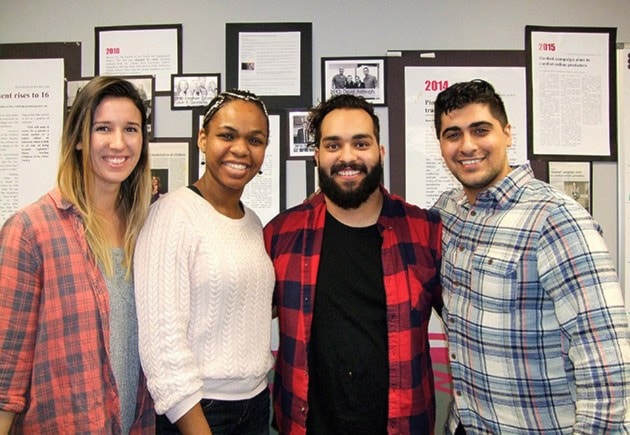Kids are curious creatures; if you give them a playground they’ll explore it.
And the most intriguing playground of all is the internet. There are social media sites, new and exciting “friends” to be found, images to see and so much more. It’s also the most dangerous playground of all, says Diane Sowden, executive director of the Children of the Street Society, and kids are falling victim to it every day.
The Children of the Street Society is working toward educating youth, their parents and teachers in this still very new landscape of handheld dangers. They visit more than 600 schools every year throughout B.C., and are currently making rounds to select schools here in Chilliwack.
They are having conversations with students that aren’t always happening at home. They’re talking to kids about who could be behind the screen, what healthy and unhealthy relationships look like, what the risks are when sharing images, who you can reach out to if something feels wrong, and anything else the kids want to talk about.
And the kids really do want to talk about it, Sowden says. They want to talk about all of it.
“We’re upfront with them,” she says. “And we hire young people on purpose (as facilitators). They do drama, skits, games and the kids get engaged.”
They open the lines of communication to talk about exploitation, sexting, and how to stay safe while still using technology. And what they often hear from the kids is that they don’t feel comfortable talking to their parents about these issues.
There are two barriers to telling parents something feels unsafe. The first is that kids don’t think their parents can handle the truth. The second, maybe more obvious reason, is that they worry their parents will take the technology away.
But Sowden says restricting kids completely from the internet, or even tracking their movements online, is not the best solution. Open communication and setting limits — like keeping phones out of bedrooms and bathrooms — are more likely to keep a child safe in the long run.
Besides, she says, predators are always one step ahead of parents when it comes to tracking kids. They know how to isolate kids, make them feel loved or special, and how to help them sneak away from “over-protectiveness.”
Society is never going to go backward and disconnect, Sowden adds.
“But we have to do this in a safe way and we have to talk to kids about it,” she says. “The day you give a device to a child is the day you talk to them about safety. The computer is the new playground and that’s where the predators are.”
She has seen cases of children being groomed for long periods over the internet, until the child believes they have a valid relationship with someone. With technology now, plane tickets can be bought and sent via email, and kids can be advertised, bought and sold, all online.
They reach out to students as young as Grade 5, and up to Grade 12. While the overarching message of safety is the same, the content is adjusted for age appropriateness.
“But if they’re not educated, they’re at risk,” Sowden says.
They see about 27,000 students every school year, and during their presentations students are allowed to leave if they need to. Many youth have been through the very situations they describe in presentations, and it can be upsetting to hear. Any student who has to leave a presentation is met with a counsellor. Every year, Sowden says, they have anywhere from 50 to 70 cases where a student discloses information that results in further action being taken.
It’s stats like that that keep the Children of the Street Society popular among educators. Because for all of the students who end up in a tough situation, on the street or involved in exploitation or prostitution, only about 70 per cent make it back out again.
That means keeping them safe in the first place is crucial, Sowden says.
“It we do get a disclosure and if it’s something that needs to be passed onto police or child protection, then we do that,” she says. Because once a child gets onto the streets in B.C., it’s nearly difficult to get them back.
“The rates of kids being trafficked has increased all over,” Sowden warns. “We used to see this on the street levels and now we see it in every community because of technology.”
“It’s very difficult (to get them back) and that’s why we focus on prevention and education because exiting is very difficult,” she says. “In this province we have no ability to hold a child or scoop them off the street. Even if you have a 12-year-old on the street, a 12-year-old doing heroin, there is no ability to take them. We cannot even sign a child into drug treatment, they have to sign themselves in and they can leave whenever they want.”
She said it’s up to parents to be responsible with tech devices.
“This is not the old babysitter like the TV was,” she says. “There’s a predator in that device.”
Parents need to watch behaviour and limit where phones can be in the house.
“Nude selfies don’t happen in the kitchen. They happen in the bathroom and the bedroom and technology should not be in those places.”
Children of the Street also educates parents, and last week held a parent’s night at Promontory elementary school that saw about 30 attendees. They also encourage students to go home and try to discuss the issues with their parents.
With all the schools the organization is visiting this month, that could lead to a lot of interesting talk around dinner tables.
Most of all, parents need to ask themselves this, she says: “Where are your kids’ phones at night?”
To learn more, visit Children of the Street Society online.
